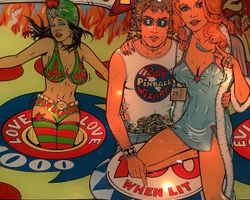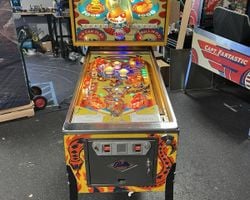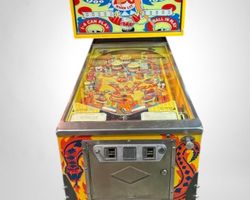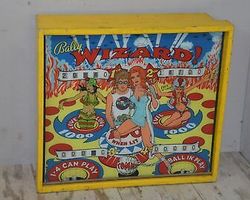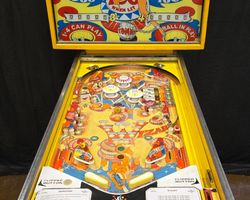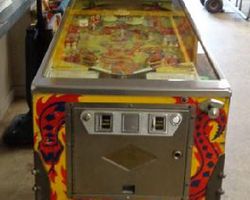Wizard!
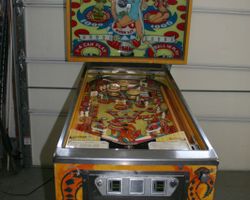
Average Prices: USD $600 to $2,400
Produced: May, 1975
Production Run: 10,005 units
Machine Type: Electro-mechanical
Players: 4
Design by: Greg Kmiec
Art by: Dave Christensen
Bally Manufacturing Corporation released "Wizard!" in May 1975, an electro-mechanical (EM) pinball machine that quickly etched its identity into the annals of pinball history. This four-player machine drew its primary inspiration from the 1975 Hollywood rock opera "Tommy," specifically capturing the essence of its "Pinball Wizard" sequence. The backglass artwork prominently features character likenesses from the film, most notably Roger Daltrey and Ann-Margret, directly tying the machine to a major cultural phenomenon of the era.
The machine's creation was a collaborative effort. The playfield layout and gameplay were conceived by Greg Kmiec, a designer known for his distinct approach to EM mechanics. The striking visual identity, from the vibrant backglass to the detailed playfield, was the work of artist Dave Christensen. Christensen's distinctive style perfectly captured the psychedelic, rock-and-roll energy of the movie, making "Wizard!" immediately recognizable. With a production run of 10,005 units, "Wizard!" was a significant release for Bally, showcasing both their design prowess and their ability to leverage popular culture. It also holds a small piece of Bally's internal history as the last EM game from the company to feature its knocker unit located within the lower cabinet; subsequent EM designs moved this component to the backbox. A subtle detail also exists on the playfield regarding the "Double Bonus" insert, which can appear in either green or blue, a variation whose origin remains a point of minor intrigue among collectors.
Signature Features and Design
"Wizard!" distinguishes itself through several unique and compelling features that contribute to its distinctive gameplay experience. The most notable innovation, and a first for any pinball machine, is the inclusion of "flip flags." These four small, rotating targets are integrated into the playfield, and their orientation directly affects gameplay, often controlling various scoring opportunities and bonus advancements. A patent for this target device, filed by Jeffrey D. Breslow in May 1975 and granted in July 1977 to Marvin Glass & Associates, underscores the novelty of this mechanism.
Beyond the mechanical innovations, the artistic design is arguably the machine's most celebrated attribute. Dave Christensen's backglass is frequently cited as one of the most compelling of the EM era, showcasing Ann-Margret and Roger Daltrey amidst a swirling, vibrant, and fantastical motif. This artwork not only visually connects the machine to its film inspiration but also establishes an energetic, almost otherworldly atmosphere. The cabinet artwork continues this thematic consistency, extending the visual appeal beyond the playfield. The machine also incorporates a spinning target, which, along with its accompanying sound, creates a satisfying feedback loop during gameplay, further drawing players into the experience. Another minor, but visually distinct, feature is a recessed standup target on the playfield, adding a subtle layer of depth to the target array.
Playfield and Mechanics
The playfield of "Wizard!" is laid out with a clear design philosophy centered on target shooting and bonus progression, characteristic of EM games of its time. The playfield includes two flippers at the bottom, providing the primary means of ball control. Three pop bumpers are centrally located, acting as chaotic elements that can propel the ball unpredictably, contributing to high score potential when the ball is caught in their active zone. Two slingshots flank the flippers, providing reactive deflections.
The core objective often revolves around hitting the eight standup targets strategically placed across the playfield, one of which is subtly recessed. Complementing these are eight star rollovers, rewarding players for skillfully navigating the ball through specific lanes. The four "flip flags" are integrated into key shot paths, requiring players to aim precisely to rotate them and activate their associated effects, which can include lighting bonus features or advancing scoring multipliers. A kick-out hole offers a satisfying reward for accurate shots, often collecting the ball and returning it to play after a bonus is awarded. A prominent spinning target, distinct from the flip flags, serves as another high-value target, contributing to both points and player engagement, especially due to its distinctive sound.
While the playfield offers a variety of targets, some players note a slight imbalance, particularly from the left flipper, which provides fewer direct shot opportunities compared to the right. Despite this, the overall flow encourages continuous action, with the pop bumpers and slingshots keeping the ball in motion, driving players to react quickly and make precise shots. The artwork on the playfield, executed by Dave Christensen, complements the backglass with its equally detailed and vibrant illustrations, tying the visual aesthetic together. The color palette and visual cues reinforce the mystical, musical theme, enhancing player immersion without relying on complex digital displays, as it uses mechanical score reels to track up to 199,990 points per player.
Gameplay Dynamics
"Wizard!" offers a gameplay experience deeply rooted in the traditions of electro-mechanical pinball, emphasizing skillful shot-making and bonus accumulation. The primary objective typically involves hitting various targets and rollovers to build up the end-of-ball bonus and advance score. The game rewards precise play, encouraging players to master the art of flipper control and nudging to maximize their score.
The unique "flip flags" introduce a dynamic element to the gameplay. Successfully hitting and rotating these flags often illuminates specific playfield features or advances the bonus multiplier, urging players to strategically target them. For instance, completing a set of flag rotations might light the kick-out hole for a higher score or enable the end-of-ball bonus to reach its maximum potential. The game's scoring system is straightforward, yet engaging, with points awarded for hitting individual targets, activating rollovers, and making shots into the kick-out hole. The spinning target, when hit repeatedly, generates a satisfying sound and rapidly accumulates points, offering a distinct high-score opportunity. The maximum displayed score per player is 199,990 points, which can be achieved through consistent play and bonus accumulation. Replay awards are managed by a replay wheel, with a maximum of 25 replays achievable. While EMs do not feature "modes" in the modern sense, the progression towards lighting the bonus and triggering replays serves as a foundational objective, pushing players to refine their technique. The satisfying chimes and knocker sound, indicating a free game, contribute to the machine's addictive quality.
Reception and Legacy
"Wizard!" has carved out a significant and largely positive reputation within the pinball community, particularly among enthusiasts of electro-mechanical machines. Its strengths are frequently highlighted, with the artwork consistently receiving commendation. Many consider Dave Christensen's backglass, featuring likenesses from "Tommy," to be one of the most striking and artistically successful of the EM era, contributing immensely to the machine's identity and collectibility. The cabinet art also garners praise for its thematic consistency and visual appeal.
The inclusion of the "flip flags" is often cited as a standout innovative feature. These mechanical elements were a novelty at the time and continue to be appreciated for the unique gameplay they introduce, adding a distinctive tactile and strategic layer. The machine's direct association with the "Tommy" movie resonates deeply with those who recall the film, fostering a sense of nostalgia that enhances the playing experience. Players generally regard "Wizard!" as a skill-based game, demanding precise shots and effective nudging to achieve high scores, which appeals to those who value mechanical proficiency over complex rule sets. The distinctive sound of the spinning target and the overall energetic gameplay are frequently mentioned as factors that make the machine captivating and enjoyable for extended play sessions.
However, "Wizard!" is not without its critical observations. Some players note that the playfield layout can feel unbalanced, particularly regarding the shots available from the left flipper, which are perceived as less varied than those from the right. A recurring sentiment is that the gameplay, while engaging, can become somewhat repetitive over time, as the objectives are relatively straightforward and do not evolve significantly during a game. Additionally, while the flip flags are a celebrated feature, some commentators point out that they occupy a considerable amount of playfield real estate, potentially limiting the space for other interactive elements. The scoring system, while intuitive, can lead to scores rolling over the mechanical reels relatively easily, which some find detracts slightly from the challenge of achieving exceptionally high, unique scores. Despite these points, the overall sentiment remains overwhelmingly positive. "Wizard!" is widely regarded as a classic EM machine, a desirable piece for collectors, and a quintessential example of Bally's output during that period. Its pioneering use of flip flags cemented its place in pinball design history, influencing subsequent designs and demonstrating the potential for innovative mechanical features in pinball machines.
Sponsored Links
 Ebay Listings
Ebay Listings
 Auction Results
Auction Results
| Cost | Location | Date |
|---|---|---|
| USD $1,100 |  United States United States |
25 December, 2025 |
| USD $3,988 |  Florida, United States Florida, United States |
30 November, 2025 |
| USD $800 |  United States United States |
22 November, 2025 |
| USD $1,000 |  Missouri, United States Missouri, United States |
27 September, 2025 |
| USD $3,500 |  Pennsylvania, United States Pennsylvania, United States |
19 July, 2025 |
| USD $3,495 |  California, United States California, United States |
28 May, 2025 |
| USD $3,989 |  Florida, United States Florida, United States |
25 April, 2025 |
| USD $1,350 |  Michigan, United States Michigan, United States |
25 March, 2025 |
| USD $2,499 |  United States United States |
11 March, 2025 |
| USD $2,300 |  California, United States California, United States |
02 January, 2025 |


Private Policy · Search Website · Contact Us
As an eBay Partner, we may earn a commission from qualifying purchases made through links on this site, at no additional cost to you.
All trademarks and copyrighted materials remain property of their respective owners. All other content copyright 2007 - 2026 Pinpedia.

